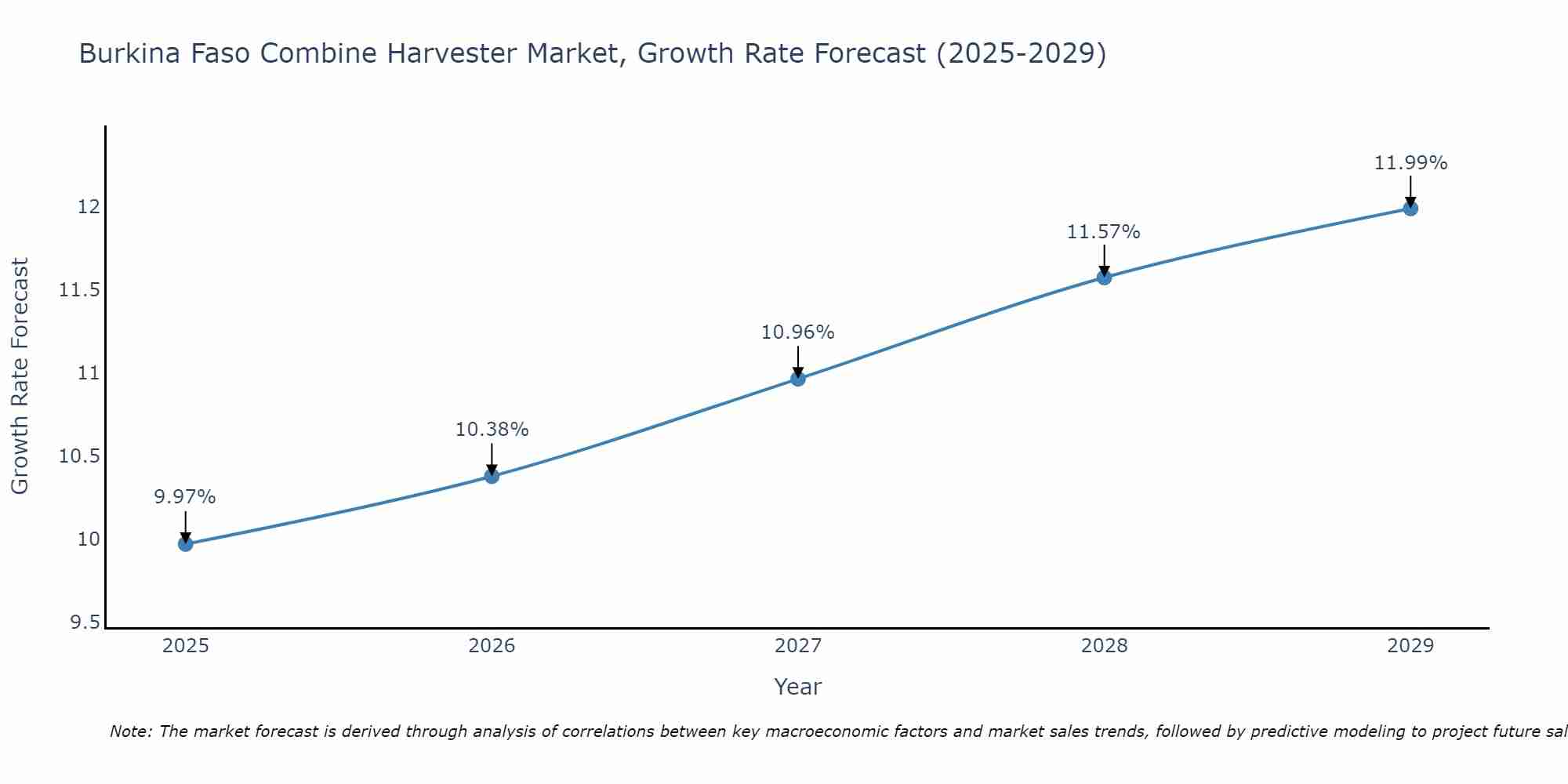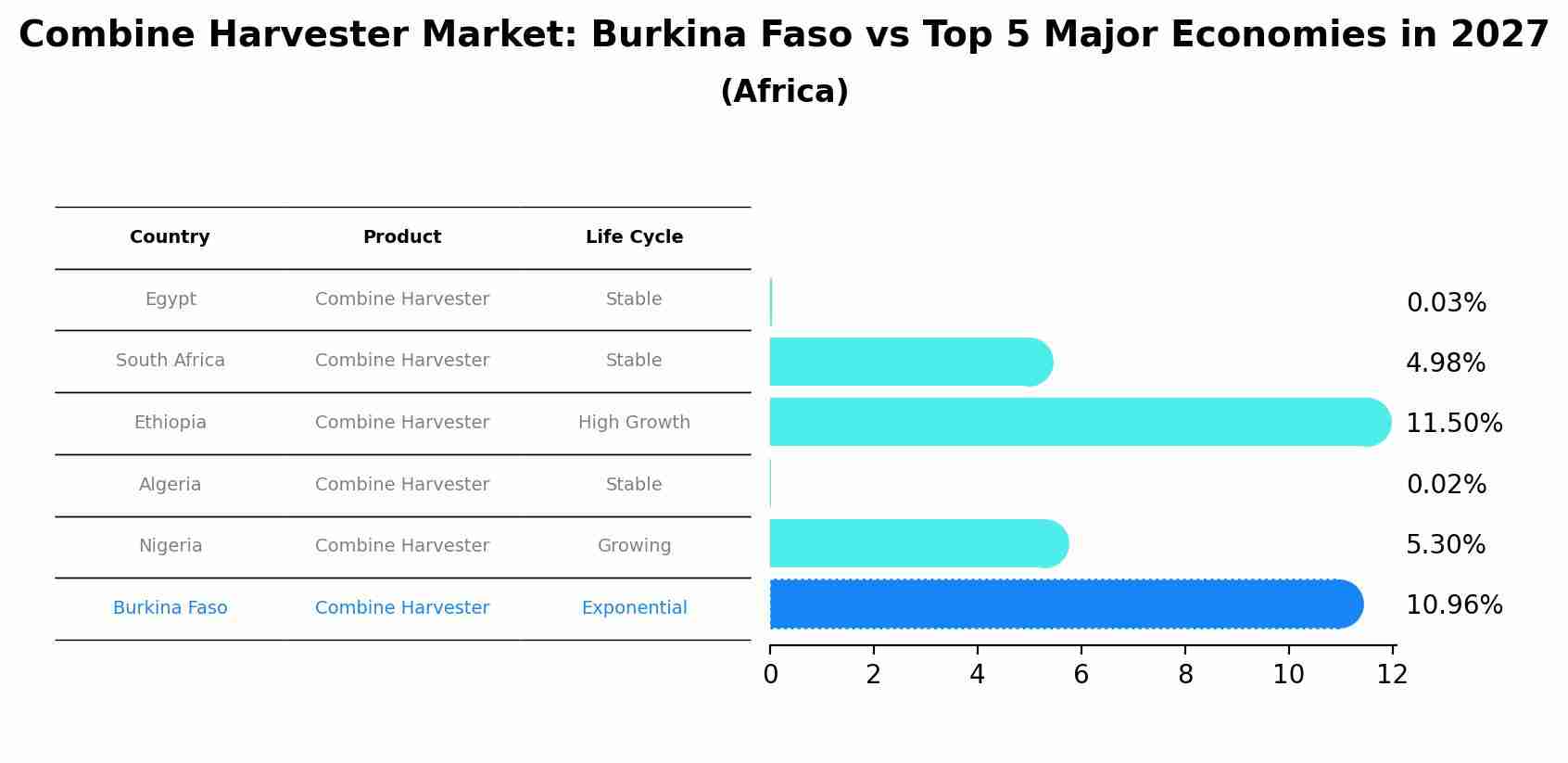Burkina Faso Combine Harvester Market (2025-2031) | Revenue, Industry, Analysis, Size, Growth, Outlook, Value, Segmentation, Companies, Trends, Share & Forecast
| Product Code: ETC5398216 | Publication Date: Nov 2023 | Updated Date: Oct 2025 | Product Type: Market Research Report | |
| Publisher: 6Wresearch | Author: Bhawna Singh | No. of Pages: 60 | No. of Figures: 30 | No. of Tables: 5 |
Burkina Faso Combine Harvester Market Size Growth Rate
The Burkina Faso Combine Harvester Market is likely to experience consistent growth rate gains over the period 2025 to 2029. The growth rate starts at 9.97% in 2025 and reaches 11.99% by 2029.

Combine Harvester Market: Burkina Faso vs Top 5 Major Economies in 2027 (Africa)
By 2027, Burkina Faso's Combine Harvester market is forecasted to achieve a high growth rate of 10.96%, with Egypt leading the Africa region, followed by South Africa, Ethiopia, Algeria and Nigeria.

Burkina Faso Combine Harvester Market Overview
The combine harvester market in Burkina Faso is shaped by the country`s agricultural sector, which relies on modern equipment to improve productivity. Challenges include the high cost of imported machinery, limited access to financing for small-scale farmers, and a lack of local service and repair facilities. Additionally, the market faces issues related to the adaptability of combine harvesters to local crop varieties and farming practices. Addressing these challenges requires efforts to improve access to affordable equipment, provide training for operators, and develop local support networks.
Drivers of the market
The combine harvester market in Burkina Faso is driven by the need for efficient agricultural practices to boost productivity and manage large-scale farming operations. The growth of the agriculture sector, coupled with the drive for mechanization to enhance crop yield and reduce labor costs, is a major factor. Additionally, government initiatives to support agricultural development and the adoption of modern farming technologies are contributing to the market`s expansion. Increased awareness of the benefits of combine harvesters in improving harvest efficiency also supports market growth.
Challenges of the market
The combine harvester market in Burkina Faso encounters challenges related to the high cost of advanced agricultural machinery and limited access to financing for small-scale farmers. Additionally, there is a need for improved infrastructure and maintenance services to support the effective use of combine harvesters. Seasonal variability and climatic conditions also impact the market demand and operational efficiency.
Government Policy of the market
The combine harvester market in Burkina Faso is guided by agricultural policies aimed at improving food security and enhancing farming efficiency. The government promotes the adoption of modern agricultural machinery, including combine harvesters, to boost productivity and support the country`s agricultural sector. Policies include incentives for farmers to invest in new technology, subsidies for agricultural machinery, and support for research and development in farming equipment. Additionally, the government works on improving infrastructure to facilitate the distribution and maintenance of harvesters. These measures are designed to increase agricultural output and support the livelihoods of farmers across the country.
Key Highlights of the Report:
- Burkina Faso Combine Harvester Market Outlook
- Market Size of Burkina Faso Combine Harvester Market, 2024
- Forecast of Burkina Faso Combine Harvester Market, 2031
- Historical Data and Forecast of Burkina Faso Combine Harvester Revenues & Volume for the Period 2021-2031
- Burkina Faso Combine Harvester Market Trend Evolution
- Burkina Faso Combine Harvester Market Drivers and Challenges
- Burkina Faso Combine Harvester Price Trends
- Burkina Faso Combine Harvester Porter`s Five Forces
- Burkina Faso Combine Harvester Industry Life Cycle
- Historical Data and Forecast of Burkina Faso Combine Harvester Market Revenues & Volume By Cutting Width for the Period 2021-2031
- Historical Data and Forecast of Burkina Faso Combine Harvester Market Revenues & Volume By Small Size Combine Harvester for the Period 2021-2031
- Historical Data and Forecast of Burkina Faso Combine Harvester Market Revenues & Volume By Large Size Combine Harvester for the Period 2021-2031
- Historical Data and Forecast of Burkina Faso Combine Harvester Market Revenues & Volume By Type for the Period 2021-2031
- Historical Data and Forecast of Burkina Faso Combine Harvester Market Revenues & Volume By Wheel Type Combine Harvester for the Period 2021-2031
- Historical Data and Forecast of Burkina Faso Combine Harvester Market Revenues & Volume By Crawler Type Combine Harvester for the Period 2021-2031
- Historical Data and Forecast of Burkina Faso Combine Harvester Market Revenues & Volume By Power Source for the Period 2021-2031
- Historical Data and Forecast of Burkina Faso Combine Harvester Market Revenues & Volume By Tractor Pulled/PTO Powered Combine Harvester for the Period 2021-2031
- Historical Data and Forecast of Burkina Faso Combine Harvester Market Revenues & Volume By Self-Propelled Combine Harvester for the Period 2021-2031
- Burkina Faso Combine Harvester Import Export Trade Statistics
- Market Opportunity Assessment By Cutting Width
- Market Opportunity Assessment By Type
- Market Opportunity Assessment By Power Source
- Burkina Faso Combine Harvester Top Companies Market Share
- Burkina Faso Combine Harvester Competitive Benchmarking By Technical and Operational Parameters
- Burkina Faso Combine Harvester Company Profiles
- Burkina Faso Combine Harvester Key Strategic Recommendations
Frequently Asked Questions About the Market Study (FAQs):
1 Executive Summary |
2 Introduction |
2.1 Key Highlights of the Report |
2.2 Report Description |
2.3 Market Scope & Segmentation |
2.4 Research Methodology |
2.5 Assumptions |
3 Burkina Faso Combine Harvester Market Overview |
3.1 Burkina Faso Country Macro Economic Indicators |
3.2 Burkina Faso Combine Harvester Market Revenues & Volume, 2021 & 2031F |
3.3 Burkina Faso Combine Harvester Market - Industry Life Cycle |
3.4 Burkina Faso Combine Harvester Market - Porter's Five Forces |
3.5 Burkina Faso Combine Harvester Market Revenues & Volume Share, By Cutting Width, 2021 & 2031F |
3.6 Burkina Faso Combine Harvester Market Revenues & Volume Share, By Type, 2021 & 2031F |
3.7 Burkina Faso Combine Harvester Market Revenues & Volume Share, By Power Source, 2021 & 2031F |
4 Burkina Faso Combine Harvester Market Dynamics |
4.1 Impact Analysis |
4.2 Market Drivers |
4.2.1 Increasing adoption of mechanized farming practices in Burkina Faso |
4.2.2 Government initiatives to promote agricultural mechanization |
4.2.3 Growing demand for efficient and time-saving agricultural equipment in the country |
4.3 Market Restraints |
4.3.1 High initial investment cost of combine harvesters |
4.3.2 Limited access to financing options for small-scale farmers in Burkina Faso |
4.3.3 Lack of technical expertise and support for operating and maintaining combine harvesters |
5 Burkina Faso Combine Harvester Market Trends |
6 Burkina Faso Combine Harvester Market Segmentations |
6.1 Burkina Faso Combine Harvester Market, By Cutting Width |
6.1.1 Overview and Analysis |
6.1.2 Burkina Faso Combine Harvester Market Revenues & Volume, By Small Size Combine Harvester, 2021-2031F |
6.1.3 Burkina Faso Combine Harvester Market Revenues & Volume, By Large Size Combine Harvester, 2021-2031F |
6.2 Burkina Faso Combine Harvester Market, By Type |
6.2.1 Overview and Analysis |
6.2.2 Burkina Faso Combine Harvester Market Revenues & Volume, By Wheel Type Combine Harvester, 2021-2031F |
6.2.3 Burkina Faso Combine Harvester Market Revenues & Volume, By Crawler Type Combine Harvester, 2021-2031F |
6.3 Burkina Faso Combine Harvester Market, By Power Source |
6.3.1 Overview and Analysis |
6.3.2 Burkina Faso Combine Harvester Market Revenues & Volume, By Tractor Pulled/PTO Powered Combine Harvester, 2021-2031F |
6.3.3 Burkina Faso Combine Harvester Market Revenues & Volume, By Self-Propelled Combine Harvester, 2021-2031F |
7 Burkina Faso Combine Harvester Market Import-Export Trade Statistics |
7.1 Burkina Faso Combine Harvester Market Export to Major Countries |
7.2 Burkina Faso Combine Harvester Market Imports from Major Countries |
8 Burkina Faso Combine Harvester Market Key Performance Indicators |
8.1 Average annual utilization rate of combine harvesters in Burkina Faso |
8.2 Percentage increase in mechanized farming practices year-over-year |
8.3 Rate of adoption of combine harvesters by small-scale farmers |
9 Burkina Faso Combine Harvester Market - Opportunity Assessment |
9.1 Burkina Faso Combine Harvester Market Opportunity Assessment, By Cutting Width, 2021 & 2031F |
9.2 Burkina Faso Combine Harvester Market Opportunity Assessment, By Type, 2021 & 2031F |
9.3 Burkina Faso Combine Harvester Market Opportunity Assessment, By Power Source, 2021 & 2031F |
10 Burkina Faso Combine Harvester Market - Competitive Landscape |
10.1 Burkina Faso Combine Harvester Market Revenue Share, By Companies, 2024 |
10.2 Burkina Faso Combine Harvester Market Competitive Benchmarking, By Operating and Technical Parameters |
11 Company Profiles |
12 Recommendations | 13 Disclaimer |
- Single User License$ 1,995
- Department License$ 2,400
- Site License$ 3,120
- Global License$ 3,795
Search
Thought Leadership and Analyst Meet
Our Clients
Related Reports
- Germany Breakfast Food Market (2026-2032) | Industry, Share, Growth, Size, Companies, Value, Analysis, Revenue, Trends, Forecast & Outlook
- Australia Briquette Market (2025-2031) | Growth, Size, Revenue, Forecast, Analysis, Trends, Value, Share, Industry & Companies
- Vietnam System Integrator Market (2025-2031) | Size, Companies, Analysis, Industry, Value, Forecast, Growth, Trends, Revenue & Share
- ASEAN and Thailand Brain Health Supplements Market (2025-2031) | Strategy, Consumer Insights, Analysis, Investment Trends, Opportunities, Growth, Size, Share, Industry, Revenue, Segments, Value, Segmentation, Supply, Forecast, Restraints, Outlook, Competition, Drivers, Trends, Demand, Pricing Analysis, Competitive, Strategic Insights, Companies, Challenges
- ASEAN Bearings Market (2025-2031) | Strategy, Consumer Insights, Analysis, Investment Trends, Opportunities, Growth, Size, Share, Industry, Revenue, Segments, Value, Segmentation, Supply, Forecast, Restraints, Outlook, Competition, Drivers, Trends, Demand, Pricing Analysis, Competitive, Strategic Insights, Companies, Challenges
- Europe Flooring Market (2025-2031) | Outlook, Share, Industry, Trends, Forecast, Companies, Revenue, Size, Analysis, Growth & Value
- Saudi Arabia Manlift Market (2025-2031) | Outlook, Size, Growth, Trends, Companies, Industry, Revenue, Value, Share, Forecast & Analysis
- Uganda Excavator, Crane, and Wheel Loaders Market (2025-2031) | Strategy, Consumer Insights, Analysis, Investment Trends, Opportunities, Growth, Size, Share, Industry, Revenue, Segments, Value, Segmentation, Supply, Forecast, Restraints, Outlook, Competition, Drivers, Trends, Demand, Pricing Analysis, Competitive, Strategic Insights, Companies, Challenges
- Rwanda Excavator, Crane, and Wheel Loaders Market (2025-2031) | Strategy, Consumer Insights, Analysis, Investment Trends, Opportunities, Growth, Size, Share, Industry, Revenue, Segments, Value, Segmentation, Supply, Forecast, Restraints, Outlook, Competition, Drivers, Trends, Demand, Pricing Analysis, Competitive, Strategic Insights, Companies, Challenges
- Kenya Excavator, Crane, and Wheel Loaders Market (2025-2031) | Strategy, Consumer Insights, Analysis, Investment Trends, Opportunities, Growth, Size, Share, Industry, Revenue, Segments, Value, Segmentation, Supply, Forecast, Restraints, Outlook, Competition, Drivers, Trends, Demand, Pricing Analysis, Competitive, Strategic Insights, Companies, Challenges
Industry Events and Analyst Meet
Whitepaper
- Middle East & Africa Commercial Security Market Click here to view more.
- Middle East & Africa Fire Safety Systems & Equipment Market Click here to view more.
- GCC Drone Market Click here to view more.
- Middle East Lighting Fixture Market Click here to view more.
- GCC Physical & Perimeter Security Market Click here to view more.
6WResearch In News
- Doha a strategic location for EV manufacturing hub: IPA Qatar
- Demand for luxury TVs surging in the GCC, says Samsung
- Empowering Growth: The Thriving Journey of Bangladesh’s Cable Industry
- Demand for luxury TVs surging in the GCC, says Samsung
- Video call with a traditional healer? Once unthinkable, it’s now common in South Africa
- Intelligent Buildings To Smooth GCC’s Path To Net Zero


















